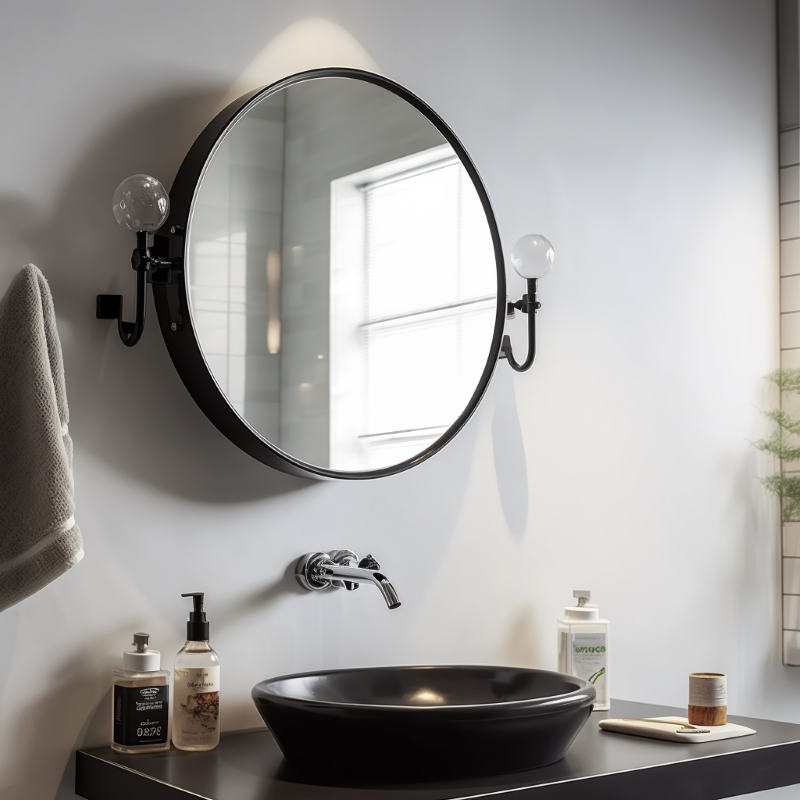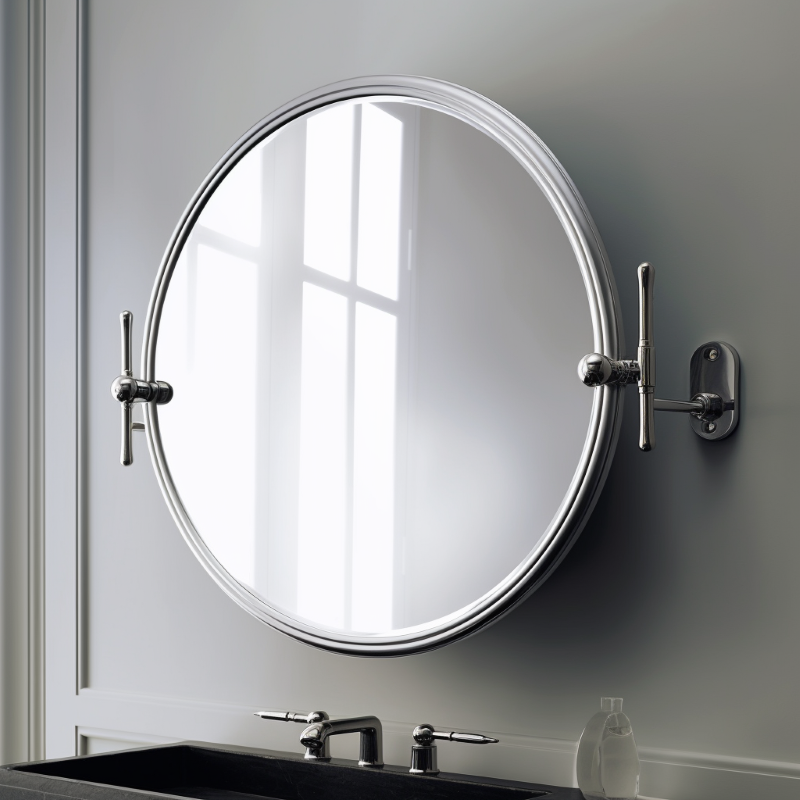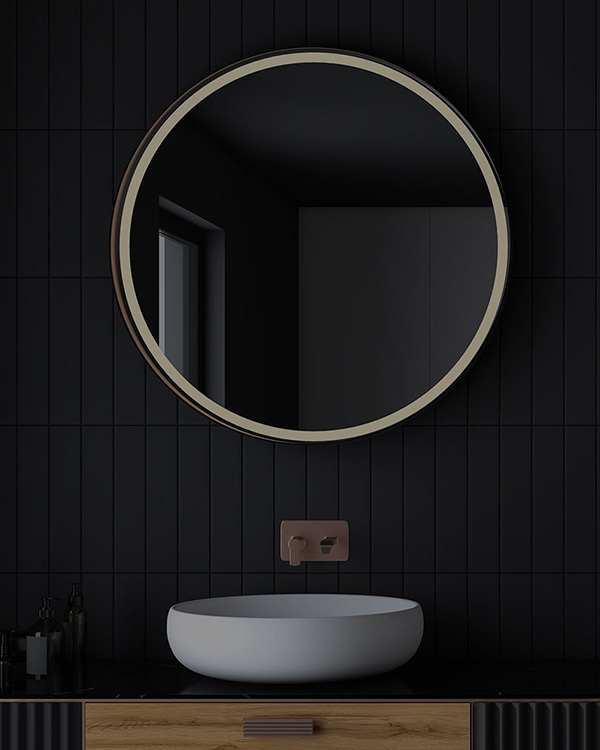What is Tiltable Bathroom Mirrors?
Tiltable bathroom mirrors are still a popular and practical option on the market. Although this style of mirror is not the latest and most design-rich, it has a classic shape and provides the user with the flexibility to adjust the angle for better viewing (especially when performing shaving or applying makeup). When waiting for work), it is still a mirror that most families will purchase frequently for traditional decoration. What’s more, This adjustability renders them particularly user-friendly, and can accommodate different heights and mirror reflection angles. They are a paragon of ergonomic design in the bathroom setting.

Tiltable bathroom mirrors supplier
Diverse Market Demand: As a supplier of bathroom mirrors, offering tiltable mirrors can cater to a broad spectrum of customers. These mirrors are sought after for both residential and commercial settings, such as hotels, shopping mall or luxury apartments.
Customization and Quality: Suppliers must focus on the quality of the tilting mechanism and the durability of the mirror itself. The ability to customize sizes and styles can be a significant selling point in the wholesale market.
In summary, tiltable bathroom mirrors blend functionality with elegance, and understanding their market dynamics from a supplier and wholesale perspective is crucial. As a company committed to quality and innovation, focusing on these aspects can strengthen your position in the global market, especially in regions like Europe, America, Australia, and the Middle East.

Features of Tiltable Bathroom Mirrors
Tiltable mirrors offer adjustable angles, allowing users to customize the mirror's position to their height and specific needs. This feature is especially useful for tasks like shaving, applying makeup, or general grooming. The features of tiltable bathroom mirrors reflect a blend of elegance, functionality, and thoughtful design, catering to the needs of a diverse range of users.
1. Adjustability and Flexibility
Tilting Mechanism: The key feature of these mirrors is their ability to tilt, allowing users to adjust the angle for optimal viewing. This is especially useful in environments catering to people of varying heights and needs.
Customizable Angles: Some models offer fixed angles, while others allow for a more fluid range of motion.
2. Design and Aesthetics
Elegant Frames or Frameless Designs: Options vary from sleek frameless designs to more traditional framed ones, catering to different aesthetic preferences.
Variety of Shapes and Sizes: These mirrors come in various shapes like oval, rectangular, or bespoke designs, fitting various bathroom layouts and styles.
3. Enhanced Functionality
Integrated Lighting: Some tiltable mirrors incorporate LED lighting, providing better illumination for tasks like shaving or makeup application.
Anti-Fog Features: A practical addition, especially in humid bathroom environments, ensuring clear visibility at all times.
4. Durability and Quality
High-Quality Materials: Use of robust materials for both the mirror and the tilting mechanism ensures longevity and safety.
Moisture and Corrosion Resistance: Essential for the bathroom environment to maintain the mirror's aesthetic appeal over time.
5. Ease of Installation and Maintenance
User-Friendly Installation: Designed to be easily mounted on various wall types.
Low Maintenance: Surfaces that are easy to clean and resistant to common bathroom stains and chemicals.
6. Safety Features
Shatterproof Options: Some mirrors are designed to be shatterproof, adding an extra layer of safety in bathroom environments.
Secure Mounting Systems: Ensures the mirror remains firmly in place once installed.
7. Customization for Diverse Markets
Adaptable to Different Markets: Tailoring design and functionality to suit the preferences and needs of different regional markets like Europe, America, Australia, and the Middle East.
Application of Tiltable Bathroom Mirrors
Tiltable bathroom mirrors are commonly used in a variety of settings, including residential, hotel, and commercial spaces. They are particularly popular in bathrooms, where users require adjustable mirrors to suit their personal preferences and needs. The flexibility of tiltable mirrors makes them versatile and appeals to a wide range of consumers.
1. Residential Use
Personal Bathrooms: In homes, tiltable mirrors enhance the functionality of bathrooms, catering to users of different heights, such as adults and children.
Luxury Suites: They add a touch of elegance and convenience in high-end residential bathrooms, often paired with sophisticated design elements.
2. Commercial Spaces
Hotels and Resorts: They are a staple in hotel bathrooms, offering guests a customizable experience, aligning with the luxury and comfort expected in hospitality settings.
Spas and Salons: In these venues, the adjustability of the mirrors is crucial for beauty treatments, hairdressing, and makeup services.
3. Healthcare Facilities
Hospitals and Clinics: They can be particularly useful in accessible bathrooms designed for patients with varying needs, including those in wheelchairs.
4. Retail and Dressing Rooms
In clothing stores and dressing rooms, these mirrors provide customers with a better view from various angles, enhancing the shopping experience.
5. Interior Design and Decor
As a design element, they complement various interior styles, from modern minimalist to classic. They can be customized to fit the aesthetic and functional needs of different spaces.
6. Adaptive and Accessible Design
In spaces designed for accessibility, such as bathrooms for the elderly or those with disabilities, tiltable mirrors are essential for providing independence and convenience.
7. Fitness Centers and Gyms
In locker rooms and restrooms, they offer a practical solution for patrons of different heights and physiques.
Design of Tiltable Bathroom Mirrors
Many tiltable bathroom mirrors are designed with a sleek and modern aesthetic that contributes to the overall décor of the bathroom. The ability to tilt the mirror adds a dynamic element to the design.
1. Ergonomics and Adjustability
Tilting Mechanism: A smooth and sturdy tilting mechanism is essential. It should allow for easy adjustment of the mirror's angle to accommodate users of different heights and needs.
Range of Motion: The design should consider the optimal range of tilt, ensuring versatility without compromising stability or safety.
2. Aesthetics and Style
Frame Design: Choices range from sleek, frameless mirrors to those with ornate or minimalist frames, catering to different decor styles.
Shape and Size: The mirror's shape (oval, rectangular, round, etc.) and size should be thoughtfully chosen to complement the bathroom's space and layout.
Mounting Options of Tiltable Bathroom Mirrors
Tiltable mirrors often come in different mounting options, including wall-mounted and freestanding models. This installation flexibility allows users to choose the option that best suits their bathroom layout and preferences.
1. Wall-Mounted Systems
Standard Bracket Mounting: This is the most common method, where brackets are fixed to the wall, and the mirror is mounted onto these brackets. The design allows for a degree of tilting.
Rail Mounting System: A rail is affixed to the wall, and the mirror hangs on this rail, allowing for tilting adjustments. This system is often used for heavier mirrors.
Hinge-Based Systems: Mirrors are attached via hinges, enabling a smooth tilting motion. This is similar to how a picture frame tilts.
2. Freestanding Designs
While less common for tiltable mirrors, some designs come with a stand, allowing them to be placed on a surface rather than mounted to a wall.
Lighting features of Lighting features
Some tiltable bathroom mirrors come with integrated lighting features, such as LED lights. This increases visibility and makes the mirror a practical and stylish addition to the bathroom.
LED Lighting: Incorporating LED lighting can provide better visibility and add a modern touch. The lighting should be evenly distributed and pleasant to the eye.
Smart Features: Options like adjustable brightness or color temperature control can enhance the user experience.
Smart mirror technology of Tiltable Bathroom Mirrors
In recent years, there has been a trend of incorporating smart technology into bathroom mirrors. While not all tiltable mirrors have these features, some models may include features like built-in LED lighting with adjustable color temperature or Bluetooth connectivity.
1. Touchscreen Interface
Control Panel: Incorporating a touchscreen interface on the mirror surface allows users to control various functions such as lighting, streaming media, or temperature and humidity displays.
User-Friendly Design: The interface should be intuitive and responsive, making it easy for all age groups to use.
2. LED Lighting Integration
Adjustable Brightness: LED lights can be embedded around the mirror’s perimeter, with brightness control for different needs and times of the day.
Color Temperature Control: Offering warm to cool light adjustments to suit different moods and requirements, like makeup application or relaxation. And it has a memory function. After turning it off and turning it on again next time, the last used settings are still guaranteed.
3. Anti-Fog Technology
Heated Demister Pads: It is attached to the center of the back of the mirror and uses the principle of electric heating to conduct heat around the mirror to prevent condensation and ensure that the mirror remains clear even in a humid bathroom.
4. Bluetooth Connectivity
Audio Integration: Allowing users to connect their devices to play music or podcasts through built-in speakers in the mirror.
Hands-Free Calls: Enabling users to make or receive calls via Bluetooth, adding convenience.
5. Digital Display Features
Time and Temperature Display: Integrating a digital display for time, indoor and outdoor temperature, or even a calendar.
News and Weather Updates: Connecting to Wi-Fi to display news headlines or weather forecasts.
6. Voice Control Integration
Compatibility with Smart Assistants: Enabling voice commands through integration with systems like Amazon Alexa, Google Assistant, or Apple Siri.
Voice-Activated Features: Controlling lighting, music, or other smart home devices through voice commands.
7. Health and Wellness Features
Skin Analysis Tools: Some smart mirrors come with features that analyze skin health, offering tips and recommendations.
Fitness and Health Tracking: Integration with health apps to display fitness metrics or health reminders.
8. Customizable User Profiles
Personalized Settings: Allowing multiple users to create and save their personal preferences for lighting and more.
We believe that with the blessing of smart technology, with the emergence of LED mirrors and some mirrors equipped with intelligent integrated functional modules, the design trends and product popularity of mirrors will change over time, and will continue to appear new innovations in the future.


